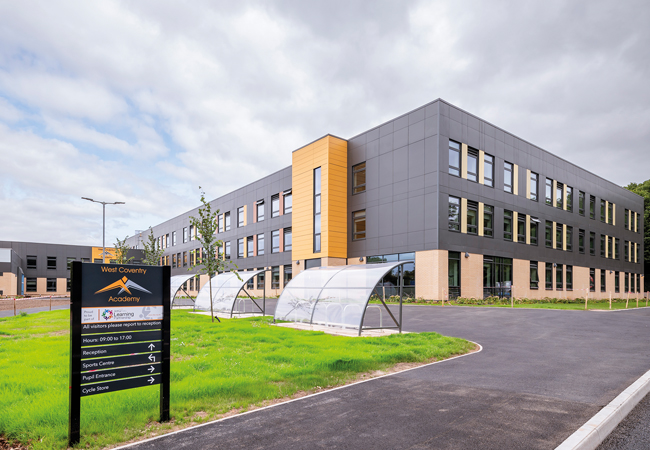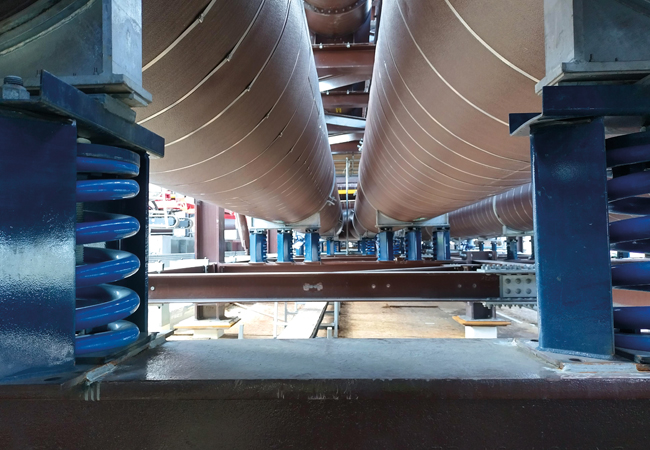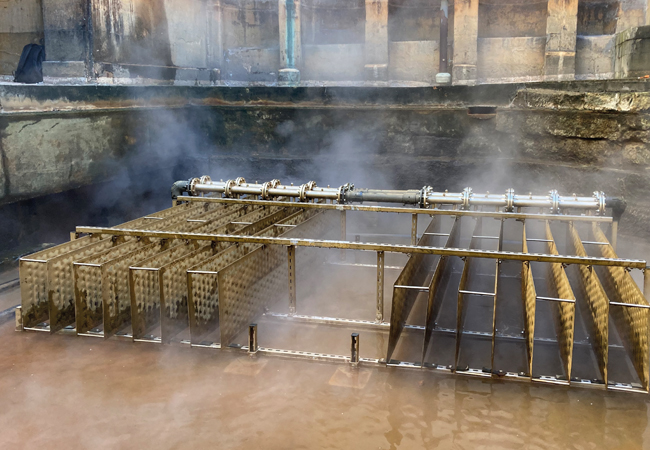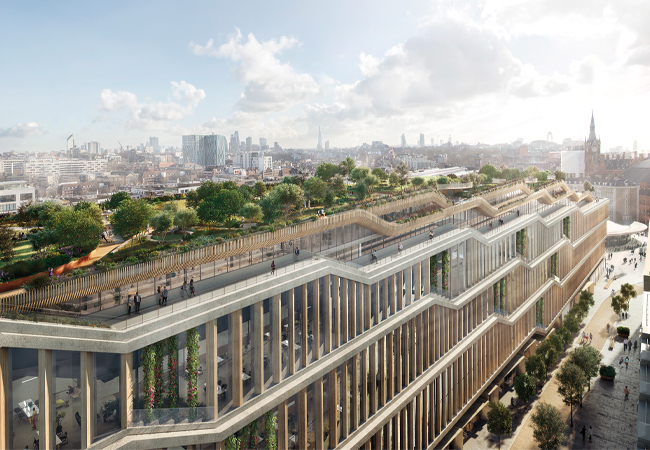
The homes at Rhiw Cefn Gwlad include photovoltaics, PV solar systems and heat pumps
With average energy bills expected to rise to more than £3,200 this October, the prospect of living in an energy-positive home has never been more attractive.
This has become a reality for residents of 14 new low-cost social homes at Stormy Downs, in Bridgend, who are experiencing zero, or even negative, annual bills.
The housing project was kick-started by the Welsh School of Architecture at Cardiff University, which had the goal to design and build an electric-powered home that put more energy back into the Grid than it took away. In 2017, a design team was instructed on using the School’s Smart Operation for a Low Carbon Energy Region (Solcer) concept, which was employed for the Stormy Downs homes.
Rhiw Cefn Gwlad is one of 10 projects in Wales sharing £43m in the second phase of the Welsh Government’s three-year Innovative Housing Programme. The grant of £839,000 brought government investment in the scheme to £2.1m, with a further £1m from Wales & West Housing.
The target was to accelerate industry learning on the development of sustainable social housing, with the aim of building 1,000 affordable homes with innovative elements, and monitoring them once occupied to understand how they performed.
At Rhiw Cefn Gwlad, homes – ranging from one-bed apartments to two- or four-bedroom houses – were constructed, and first occupied in January 2021. The key technologies proposed for them included photovoltaics (PVs), air source heat pumps (ASHPs) and PV solar systems (see panel, ‘Key technologies’, and Figure 1).
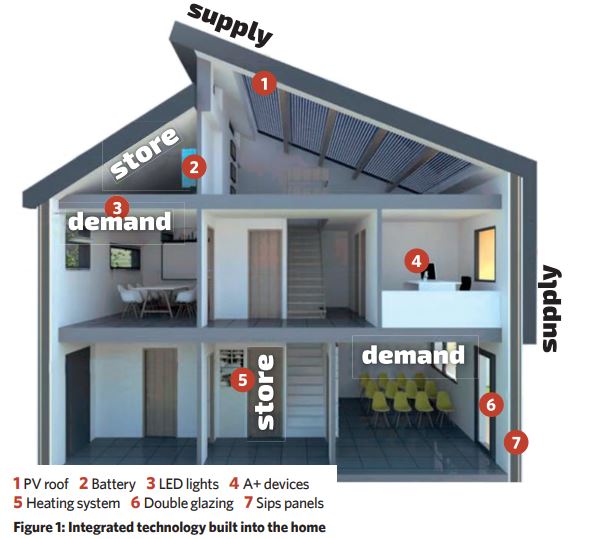
While architecturally similar to many other housing developments, the design has additional technologies not normally seen in social housing. Each house type was designed to be energy and carbon positive over a year, putting more energy back into the Grid than it takes out.
Energy predictions
In the design stage, a detailed 3D IES model was used to estimate the energy consumption and thermal performance of the homes. However, these models are not good at modelling the complex interactions between hot-water storage and varying system efficiencies, so a separate thermal-storage model was created to understand the hot-water heat pump profiles.
Finally, an electrical-storage model was developed, to consider battery storage performance and optimise the battery-control strategy for the houses.
Calculations were performed at half-hourly resolution over 12 months, and the models were combined to create a single model to optimise design, and create setpoint, control and energy strategies.
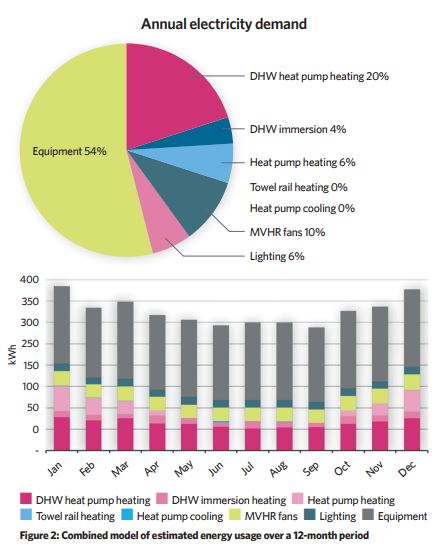
To ensure performance was measured, all the homes were designed with in-house monitoring, to allow contractors to install meters and sensors, with the aim of collecting data on imported energy, renewable energy generated, electricity sub-metering, hot-water demand, internal air temperatures, and humidity levels. Figure 2 shows the combined model of estimated energy usage over a 12-month period.
Costs
The construction guidance cost of typical Building Regulations-compliant Welsh social housing is £1,800/m2 and the average build cost of Rhiw Cefn Gwlad was £2,467/m2 – a 35% increase.
The additional costs were attributed to an improvement in building fabric, and an exhaust ASHP, integrated solar panels, heat pumps, and battery storage. The cost difference is expected to decrease as new technologies become more common in the UK, but increases in construction costs are offset by energy cost savings to the residents.
While the Rhiw Cefn Gwlad development is at the bleeding-edge of net zero carbon social housing, it is anticipated that we will see a further reduction in development costs as more low carbon technologies become mainstream.
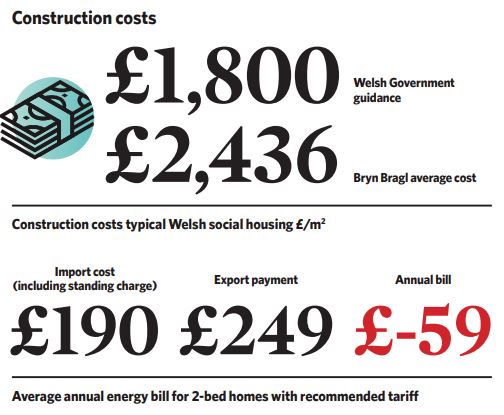
Performance
Once occupied, Hoare Lea monitored the in-use performance of the homes, and advised on any issues with the batteries, modern heating systems, and energy generation.
Performance reports were produced for all 14 homes at three-monthly intervals, to identify electricity demand, generation, import and export, thermal comfort, ASHP and battery performance, and tenant behaviour.
The first round of reports showed interesting results. Significant differences in heating setpoints across the 14 homes were identified, ranging from 19°C to 24°C. Some tenants ran their heating for 24 hours a day, seven days a week, creating an electricity demand 60% higher than the design model.
Positive and negative initial lessons were learned; the houses had no problem reaching demand temperatures, and hot-water heating was fine, with the immersion heaters only kicking in occasionally for hygiene cycles and in homes with very high hot-water usage.
User control guides, and videos for operating the heating systems for residents who were less confident, were successful, with only minor assistance required. Feedback from residents also indicated confidence in using the systems. The 13.5kWh storage batteries were filling up quickly on sunnier days, generating ample electric supply.
Some of the initial challenges were ‘top-up’ duct heaters being used too frequently, to which controls optimisation was implemented at the start of March. Compared with the design-stage models, space-heating demand was underestimated, but was balanced out by hot-water heating being overestimated.
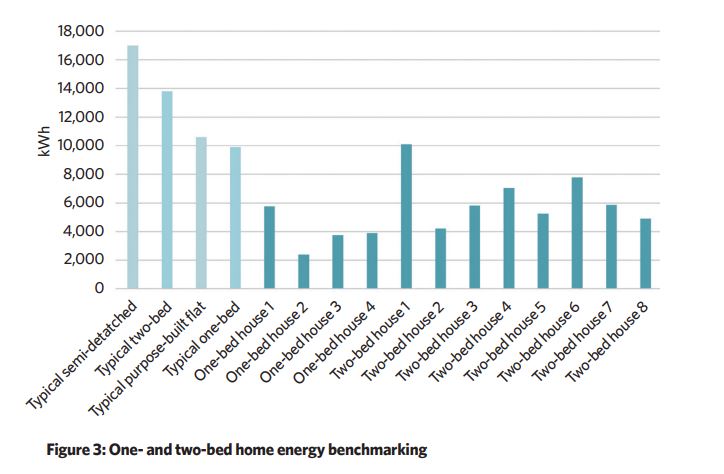
Initially, 400W electric towel rails were a problem, causing high electrical usage because residents had difficulty understanding the controls. This was rectified by implementing a two-hour timer, a more energy-efficient solution and one preferred by the residents, who finally understood how to control the towel rails.
One home had unexpectedly high electrical socket loads, which was eventually attributed to a hydrotherapy pool that the resident had fitted, which was not anticipated at design phase.
Benchmarking was performed on the properties after 12 months occupancy, to analyse the energy efficiency of the homes. The houses have been benchmarked against the National Energy Efficiency Data-Framework database, from the Department for Business, Energy and Industrial Strategy, which details the average energy consumption of UK homes, both new and existing.
To understand the underlying demand of the homes, PV generation has been removed from the comparison for the two-bed homes –and, to protect the identity of the homes, naming conventions have been removed for the following graphs.
Figures 3 and 4, show the two-bed houses performing better than the benchmark for typical two-bed and semi-detached homes. Even without the renewable energy generation, the homes are considerably more energy efficient than equivalents from the UK’s existing housing stock.
Figure 5 shows the average monthly energy imported from, and exported to, the Grid for the two-bed homes. This shows them using energy from the Grid during the six colder months, but net exporting for the warmer six months. Notably, the homes used practically no Grid electricity between April and the end of September. The purple line shows the running energy balance of these homes, which ended the 12-month period in negative territory, at around -1,000kWh. The ambitious design-stage target of ‘energy positive’ performance had been achieved. This was repeated for the average performance of the one-bed and four-bed homes.
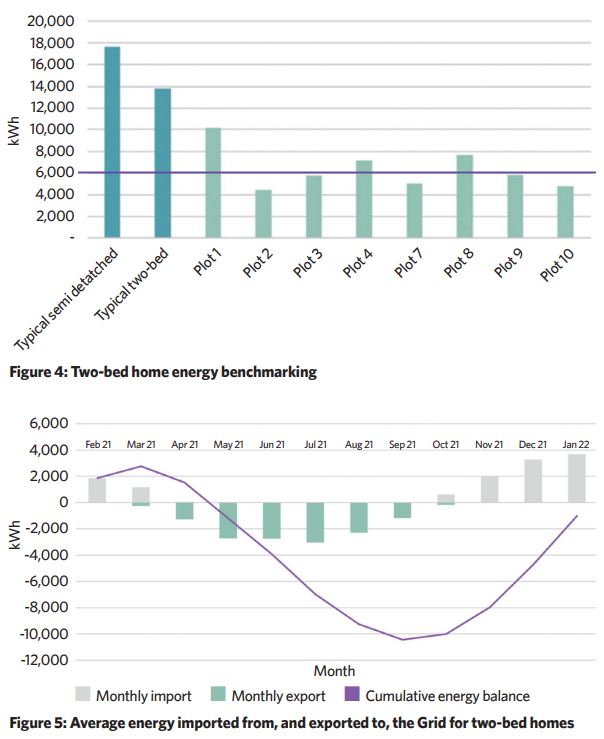
When investigating the performance of individual properties, two did not achieve the energy-positive target. One was the home with the hydrotherapy pool, while the other was one of the four-bed homes. Detailed analysis of the sub-meter data showed that the residents of this home were very high energy users with far higher than expected plug-socket loads, cooking, lighting, and towel rail usage. They also used considerably more hot water than anyone else on the site, averaging more than 400 litres/day. While this home did not achieve the energy-positive target, it was still exceptionally energy efficient, ending the year with a net energy demand from the Grid of less than 1,900kWh.
Energy costs
In addition to energy and carbon targets, the residents’ energy costs were at the forefront of the project team’s minds. These homes had to be affordable to run and part of the solution to fuel poverty, not just environmental issues. While the social landlord has no control over the energy supplier or tariff chosen by residents, it did provide recommendations on tariffs that will work with the systems within the homes, to produce the lowest bills.
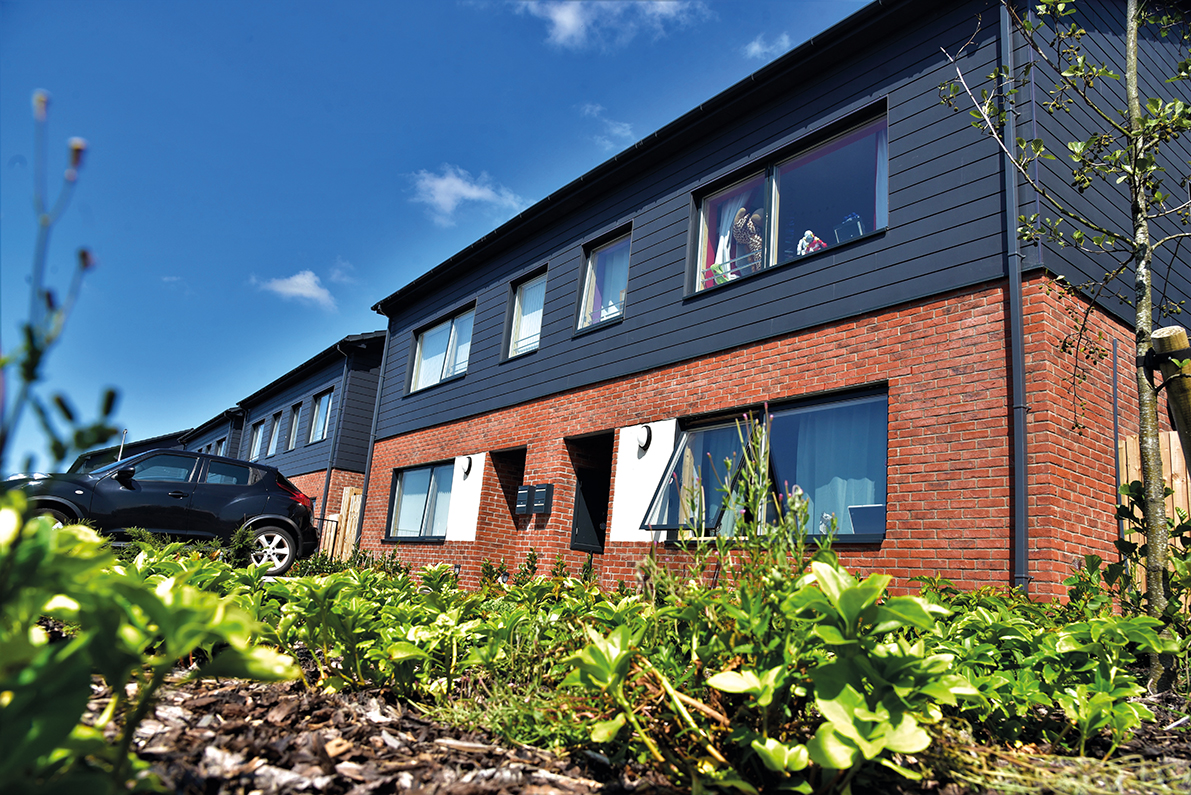
One such tariff was created by a partnership between one energy supplier and the battery supplier; if the residents used this tariff, they would have achieved exceptionally low bills over the monitoring period, with many having a negative bill over the 12 months – their home energy systems earned them money, rather than costing them money!
Given the current energy crisis and spiralling costs, the residents of these homes may be among the few people in the UK who need not worry about their energy bills this coming winter.
After the 12-month monitoring period, from February 2021 to January 2022, the conclusion was exceptionally positive, with the whole design and construction team delighted with performance. The residents were also very pleased with their homes, noting that they were comfortable, warm, and had extremely low energy bills.
Key technologies
- 3.7-7.4kW PV solar systems
- 13.5kW AC-coupled lithium-ion batteries to store electricity
- Pichler PKOM4 exhaust ASHPs for heating and hot water
- Heating delivered through a mechanical ventilation with heat recovery (MVHR) system
- Energy-efficient double-glazed windows and doors
- No gas heaters, radiators or cooling
About the author
Eimear Moloney is a director at Hoare Lea



